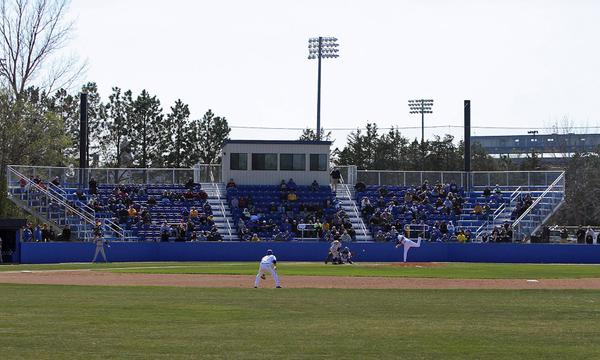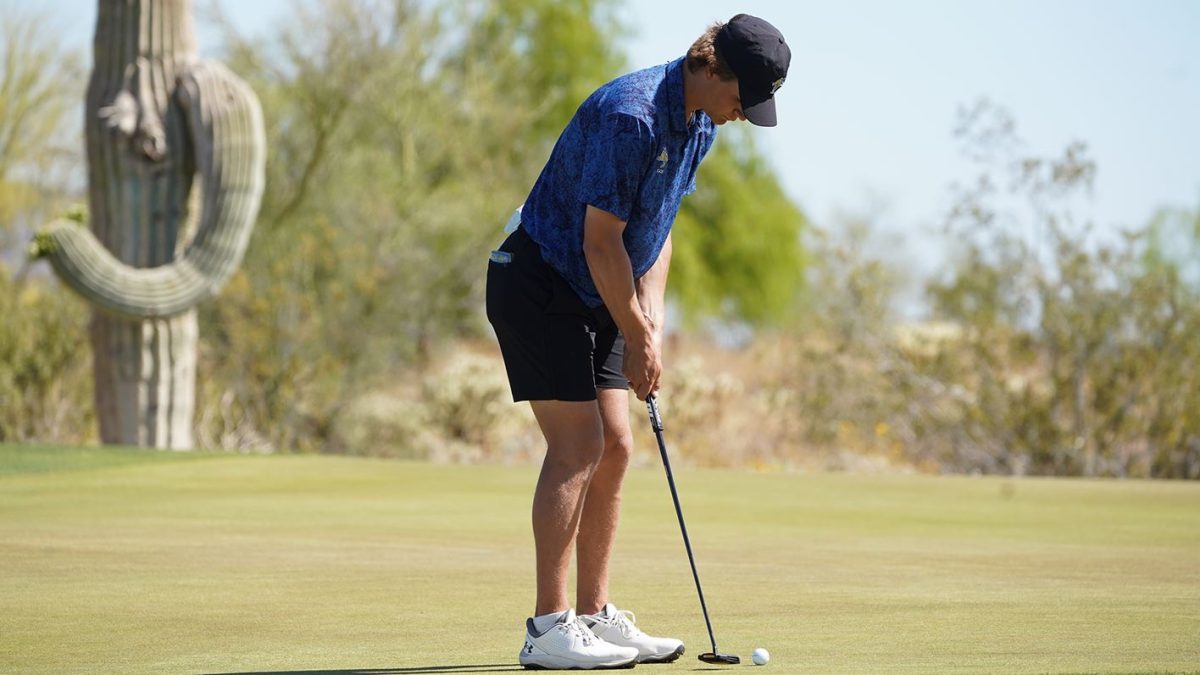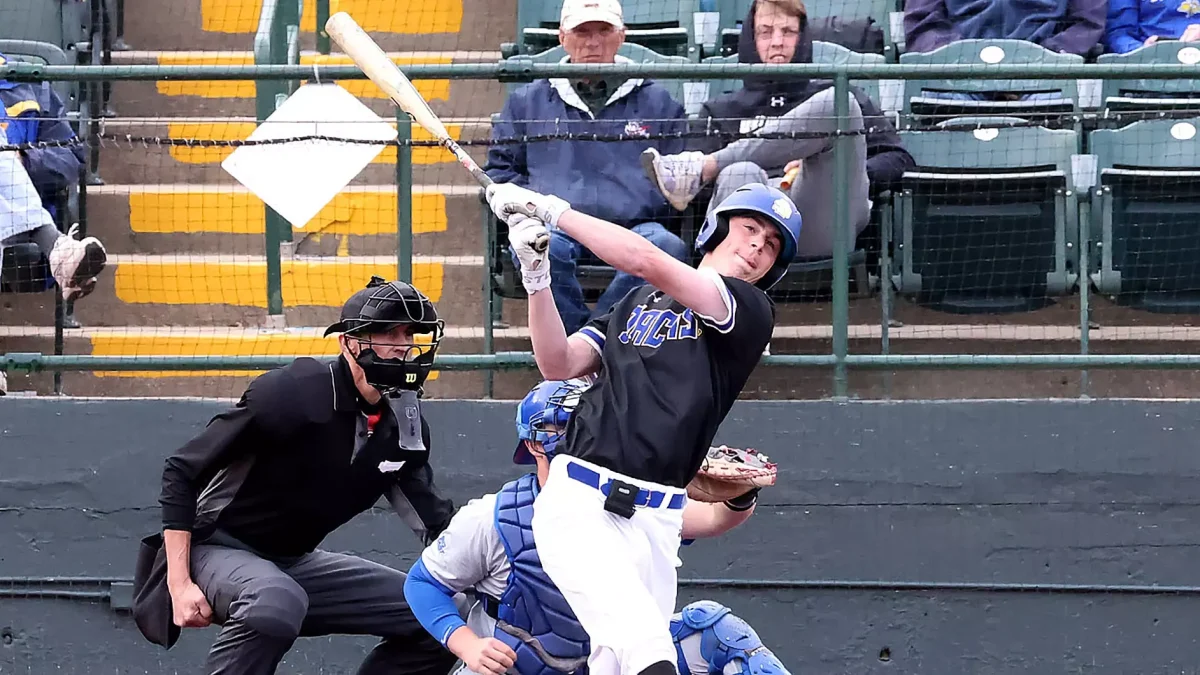The Jackrabbit baseball team will play a home series this weekend.
Finally.
After having their first two home series relocated to Omaha, the Jackrabbits are preparing to open their Summit League home slate against St. Thomas on Friday, nearly a month after their first home series was originally scheduled.
Entering the weekend, the Jackrabbits are 15-18 overall, 7-7 in the Summit League and are returning home off of a series at the University of Nebraska- Omaha, where they dropped two games after a strong start.
The Jacks now sit fourth place in the Summit League after losing six of the last 10 games. In this time the squad has been outscored 115-89 and while the bats have been working for the Jacks up to this point, the pitching has been the team’s biggest struggle.
Coach Rob Bishop, who is in his eighth season as the Jackrabbits head coach, said he’s confident about where the team stands in league play.
“We are in a good spot, from a conference standpoint. We are playing pretty good baseball,” Bishop said. “The exciting thing for me is, there is a better version of us out there.”
Bishop said that where the team is mainly lacking is with the consistency on the mound. Through the first half of conference play, the pitching staff has a combined ERA of 6.98.
Senior pitcher Nic McKay, however, has been lights out on the mound, being named the Summit League Peak Pitcher of the Week three times. He also holds the league’s lowest ERA at 2.08. He looks to be a big part of the series against St. Thomas as SDSU’s going to need their best against the No. 1 ranked team in the league.
“Being recognized and seeing hard work start to pay off is great,” McKay said. “However, having an offense that has been performing as well as ours, it makes it a ton easier on me as a pitcher. Credit goes to those guys.”
The offense that McCay is talking about has been dominant. The Jacks lead the league in home runs and slugging percentage.
Cael Frost, an outfielder who transferred from Kirkwood Community College last fall, has led the charge and has been one of the league most dominant hitters. He ranks first in home runs, slugging percentage and on base plus slugging percentage, and sits second in a majority of other batting categories. And his teammates have taken notice.
“Cael Frost has been unbelievable… being able to be with him a lot and watching him take each step forward has been incredible,” senior outfielder Reece Anderson said.
Anderson has been another weapon for the Jackrabbits offensively, averaging .337 on the season. He recently led a near comeback from a 10-1 deficit against Omaha last weekend. With a three-hit performance, Anderson recorded a grand slam in the eighth inning, bringing the score to 10-8.
The lefty-batter loaded No.1 St. Thomas’ squad makes for an interesting first home matchup with the Jackrabbits. That said, it may sound a little weird to fans that it is nearing the end of regular season play just as the home games are getting started.
Blame South Dakota winters.
The weather has served as the team’s biggest obstacle between playing on Erv Huether Field, and being relocated to Omaha. It begs the question, with so much of South Dakota State’s front half of the schedule being on the road, how does this aect the team?
Bishop thinks that being a mid-major from the north, traveling for the first half of the season is just the standard.
“When you look at us, North Dakota State, St. Thomas, and other mid-majors playing in the north… you are going to play the first four or five weekends on the road almost regardless of the situation,” Bishop said.
This takes a toll on players, and on the team as a whole. At this point in the season, the team isn’t just looking forward to being at home to have the home-field advantage, they are looking forward to sleeping in their own beds.
“At the beginning of the year everyone is looking forward to getting on the road and getting out of the cold. But as the weeks go on, the travel starts to wear and tear on our bodies,” Anderson said.
As a team, the road brings them closer, and they stay in tune mentally just by being together, but the constant travel does no good for the recovery that a Division 1 baseball player needs.
“We are all used to it; it happens every year,” Anderson said. “These next few days, being at home, getting rested up, being able to cook our own food, practicing on our own field, all these things are going to help get everyone that’s beat up healthier.”
It has been quite some time since the team has been able to practice consistently outdoors on their own field because of the conditions outside.
As with most of the other athletic teams here, the baseball team has been mainly practicing in the Sanford Athletic Jackrabbit Complex.
“We are really fortunate with the “SJAC,” said Bishop.
Obviously, practicing inside for a baseball team is less than ideal, but the team has found some solutions over the years.
“How we mitigate it is when we are outside in September and October, we think of what are the things we can’t work on in January and February, let’s double up and triple up in those areas,” said Bishop.
Bishop thinks that though his players are used to traveling, along with the players that he recruits, there are some possible solutions.
For instance, if the college baseball season started a month later, it would save at least six-figures in the budget for northern baseball teams. They would travel less, play more games at home and generate more revenue as a program.
The teams from warm climates in college baseball are put at a huge advantage.
In the last two decades, only two teams from places where it is known to snow in the winter months have made it to the college world series; University of Michigan and Fresno State.
And just as it is hard to be a baseball team in the colder climates, it is hard to want to watch baseball when it is cold.
According to the Summit League’s website, the Jacks averaged 126 fans at home throughout the 2023 season.
Their average on the road: 511.
Bishop does not think it is because there is a lack of fans wanting to watch baseball. But because nobody wants to watch baseball when the weather is uninviting.
“Go to a North Woods League collegiate game in the summer. Our guys will go play in front 4-5-6-7-8,000 fans on a given night,” said Bishop.
Another solution is a turf field.
“From a facilities standpoint, we are as fortunate as we can be with the SJAC,” Bishop said. “Having a turf field is the next step for us to be able to create the best situation that we can create… and we are working on it… I think that it is when, not if.”
The addition of a turf field would not only affect the team’s home games, but would open the field up to other community use as well.
South Dakota State’s baseball program would be able to host more camps during the summer and also tournaments. This would generate revenue for the baseball program.
Tickets at Dana J. Dykhouse Stadium, ticket sales for the basketball games at the new First Bank and Trust Arena, and the scholarship auction are all factors that play into the funding for the baseball program, according to Bishop.
However, it takes a lot more to get the project of a turf field moving.
“As a department, we have researched and had conversations with a handful of vendors regarding field turf for both baseball and softball,” said Jeff Holm, senior associate athletic director. “With that said, as is the case with most facility project, funding would have to come from individual donors or companies to support those projects.”
The department was unable to provide a timeline on the project, but the conversations are being had.
Coach Bishop believes that turf is a crucial step and that when this happens the program will really begin to take some strides.
WEATHER OFTEN WINS
With season almost over, Jacks to make Summit home debut
Jack Amer, Reporter
April 16, 2024

Era Huether Field
0
Tags:
More to Discover



















